Brown Spots On Pothos Leaves
Indoor plants can be defined as miniature gardens brought to life within homes offering natural beauty and elegance. There are several varieties of these beautiful indoor plants and Pothos is one of them. Pothos (Epipremnum aureum) is a popular indoor or house plant valued for its maintenance and air-purifying properties. It has beautiful heart shaped leaves providing a natural decorative look to indoor spaces. But, unfortunately due to various reasons brown spots on pothos leaves can be of serious concern.
Pothos plant, mostly referred to as Golden Pothos is a vining plant, native to Southeast Asia, but planted all across the globe for its various shades of green, yellow and white depending on the variety. Being an indoor plant it thrives in moderate low light.
Although it is adaptable to a wide range of light conditions, it is preferred to avoid direct sunlight. It can be easily grown in pots and like various indoor plants it also helps, purifying indoor air. So breathing in fresh air our work efficiency also improves.
In this article I’ll explain several reasons why pothos leaves turn yellow and how we can treat this problem for the best looking pothos plant in personal space.
Browning of Leaves
Browning of leaves in any plants can be a serious concern. It can be due to various unfavorable conditions. Unfavorable conditions like improper watering, non-ideal temperature and climate, infertile soil and any kind of pest and disease attack.
- Pothos are native to tropical rainforest climate and prefer warm and humid conditions.
- Suitable temperature ranges from 15-29℃. Extreme fluctuations from temperature ranges are harmful.
- Maintenance of high humidity is preferred otherwise the plant may wilt, eventually develop brown spots.
- In direct sunlight the plant tissues may burn.
These are environmental hazards for pothos. Other external factors such as fungi and disease attack may cause serious problems such as brown spots on leaves. But identifying the right cause of browning of leaves can be more difficult as different factors form different types of browning. This guide will help to identify and diagnose the cause of browning. These types of browning may involve:
For more information about Gardening you can visit: 10 Climbing Plants With Purple Flowers
Brown Spots on Leaves
- Scattered Spots: Scattered brown spots indicate symptoms of underwatering, sunburn or pest attack on plants. Observe the texture for better identification and look for other symptoms too.
- Spots with Yellow Halos: It indicates that there are fungal or bacterial diseases affecting the plant. These types of symptoms are often seen during humid conditions.
- Spots with Concentric Rings: It also indicates the presence of fungal attack
Yellowing with Brown Spots
- Overall Yellowing with Brown Spots: This is potential symptoms towards root root due to overwatering. The texture of these spots are mushy and soft.
Brown Tips and Edges
- Crispy Brown Tips: Hard and crisp brown tips indicate the sign of overwatering. Another identification is dry soil.
- Brown Edges with Curled Leaves: Pothos prefer indirect bright light. Direct sunlight can cause this condition of curled leaves with brown edges.
- Brown Edges with a Soft Texture: Overwatering and damp conditions result in brown edges with a soft texture.
Other types of brown spots may involve brown patches due to sunburn and small brown spots with insects indicating pest attack on the plant.
Causes of Brown Spots on Pothos Leaves
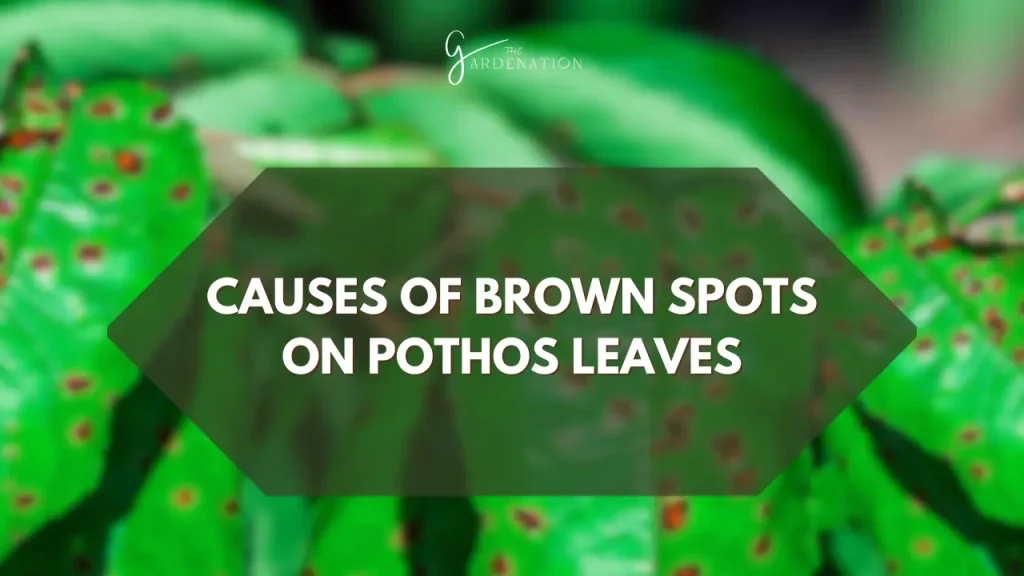
Pothos are versatile indoor species but they have very limited tolerance to external harsh conditions such as direct sunlight. They prefer warm and humid climates and extreme fluctuation such as extremely hot conditions and frost can affect their beauty. Otherly small pests and fungi like to feed on these plants causing brown spots.
Indeed there are several types and reasons for the brown spots on leave, few of them are explained below with the best treatment. We have also discussed the causes of Brown Spots On Snake Plant. Do checkout!!
- Sunburn
- Low Humidity
- Poor Soil
- Improper Waterings
- Nutrient Deficiency
- Pest Infestation
- Fungal Attack
1. Sunburn
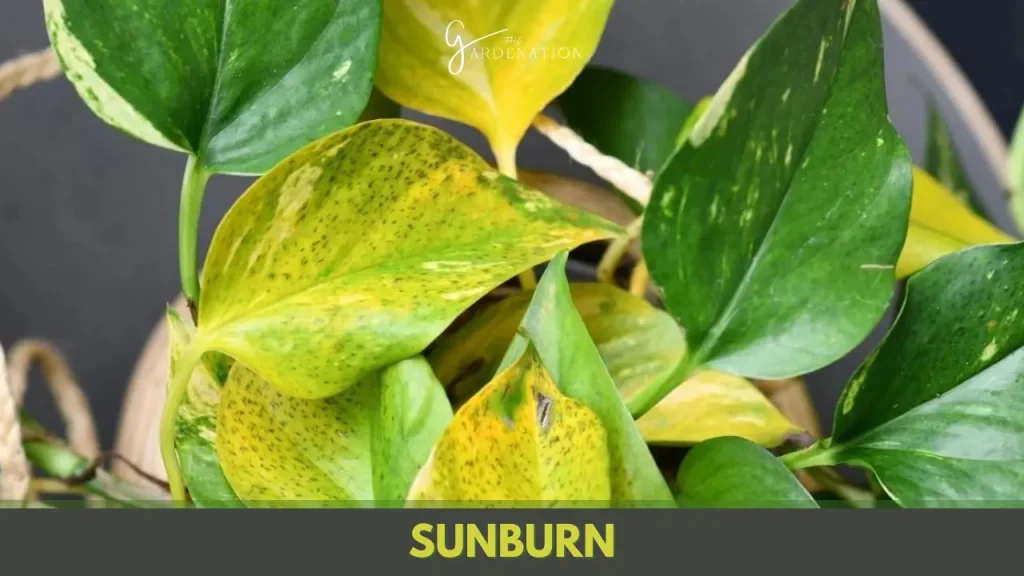
It is defined as a condition when the plant is exposed to too much sunlight. But for pothos only direct sunlight is enough to damage its tissues. They prefer indirect bright light with temperature ranges near to room temperature. However, too much high temperature with intense sunlight makes the environment hell like for plants and forms brown spots on its surface eventually leading to leaf drop.
The symptoms of sunburn may involve brown edges with curled leaves or scattered brown spots on leaves showing random necrosis. The texture of leaves due to sunburn becomes dry and crisp. If measures are not taken, it can result in loss of plant vigor.
Treatment
- Sunburn is a serious concern in pothos plants. So they must be kept away from direct sunlight and windows.
- Choose a place with shade for pothos plants even indoors, otherwise it may lose its color too.
- The sunburnt leaves are not meant to be pruned immediately as they provide protection with their shade to the underlying leaves.
- These plants are best to use on tables and niches where sunlight doesn’t reach.
2. Improper Waterings
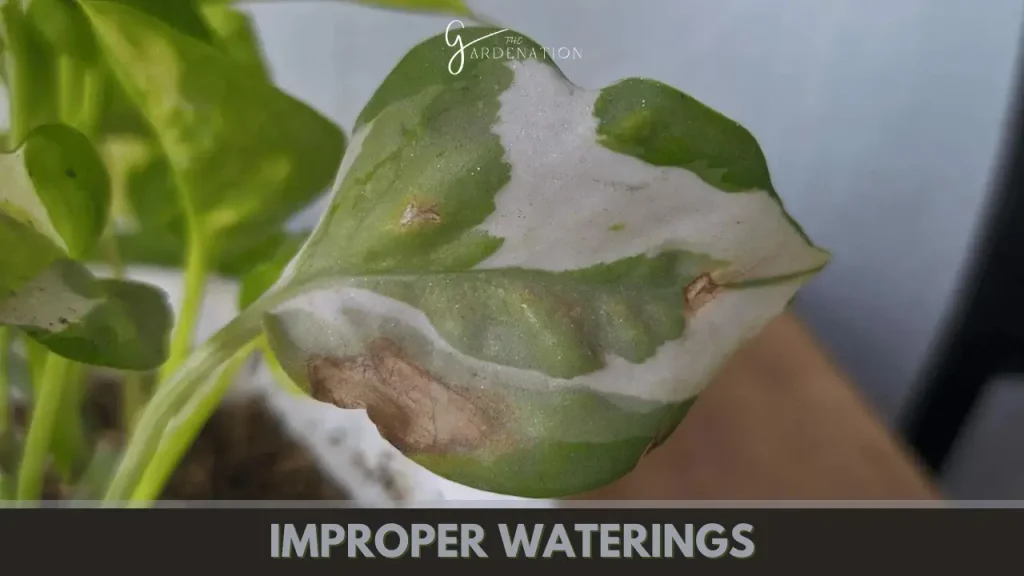
Pothos are affected badly both by overwatering and underwatering
Underwatering is a condition that occurs when the pothos plant doesn’t receive enough water to maintain its health and function. This condition can be due to infrequent watering or extremely hot and dry weather.
In this condition the soil becomes too dry separating it from the edges of the pot. The leaves will become dry and brittle and might curl inwards. Brown leaf tips and edges appear resulting in wilting, stunted growth and premature leaf drop.
Overwatering occurs when too much water is applied to the plant. However in pots plants require frequent waterings but overwatering is dangerous. This will result in water logged soil and limited oxygen availability for the roots. That’s why we prefer well drained soil for pothos as poor drained soil leads to this condition. And limited oxygen supply will eventually lead the plant to cell death starting from the root zone.
Symptoms of overwatering may involve soggy soil, brown spots on leaves that started as yellow spots. Leaves become soft and yellow and eventually drop. Root rot and fungal diseases may also occur due to overwatering.
Treatment for Under-watering and Overwatering
- To prevent drought or underwatering, water pothos plants deeply, allowing water to drain completely.
- For pots use sandy loam and silt loam soils that are well drained.
- To prevent overwatering, always let the top soil dry out before watering.
- Always make sure the drainage holes are open.
- Pruning of rotten roots is also necessary to be done carefully, for proper water intake by the roots and to prevent accumulation of excess water.
- A proper schedule of watering and soil checking must be made and maintained.
3. Low Humidity
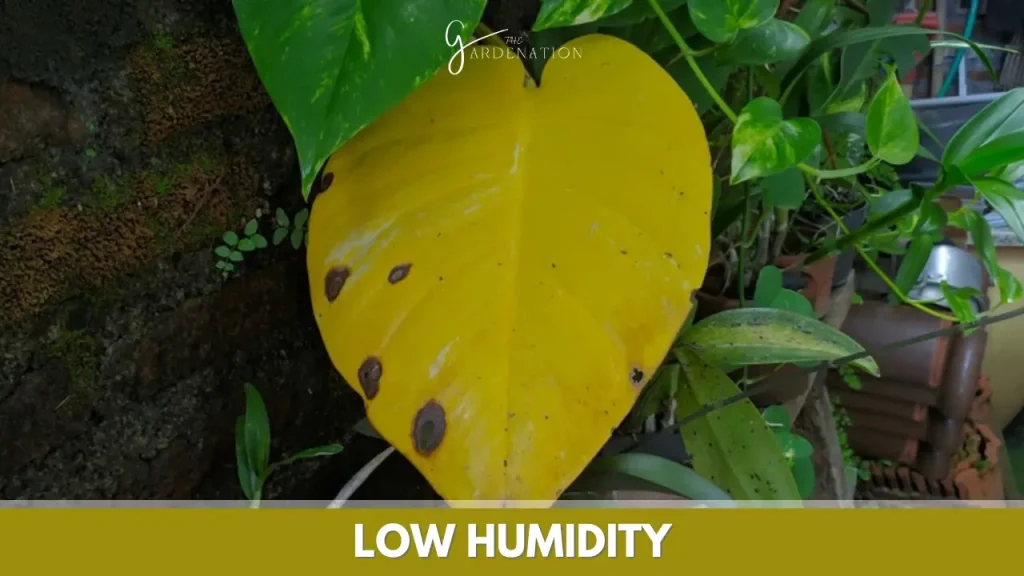
Pothos plants are native to tropical rainforest regions where humidity is high. So they prefer a high humidity (40-60%) for their surroundings. Like other plants for them, atmospheric water (water in air) is as important as water in soil. Dry environment can badly affect the plant causing the plant leaves to transpire water at faster rate and lead to dehydration, wilting even if there is sufficient water in soil.
In this condition the edges of leaves first dry out turning into crisp brown color. Low humidity slows down the growth and development of plants. Pests who prefer low humidity like spider mites can also affect the pothos plant.
Treatment
- The most preferable solution to this problem is the use of humidifiers to maintain humidity.
- If humidifiers are not easily available, use a water sprayer to produce a mist-like environment around the plant regularly. But this shouldn’t be done in direct sunlight.
- Placing plants close to each other also favors humidity to each other by transpiration process.
- Place the pot on a tray with pebbles and water. When the water evaporated it increased humidity around the plant. Note that humidity above 80% is also harmful.
4. Nutrient Deficiency
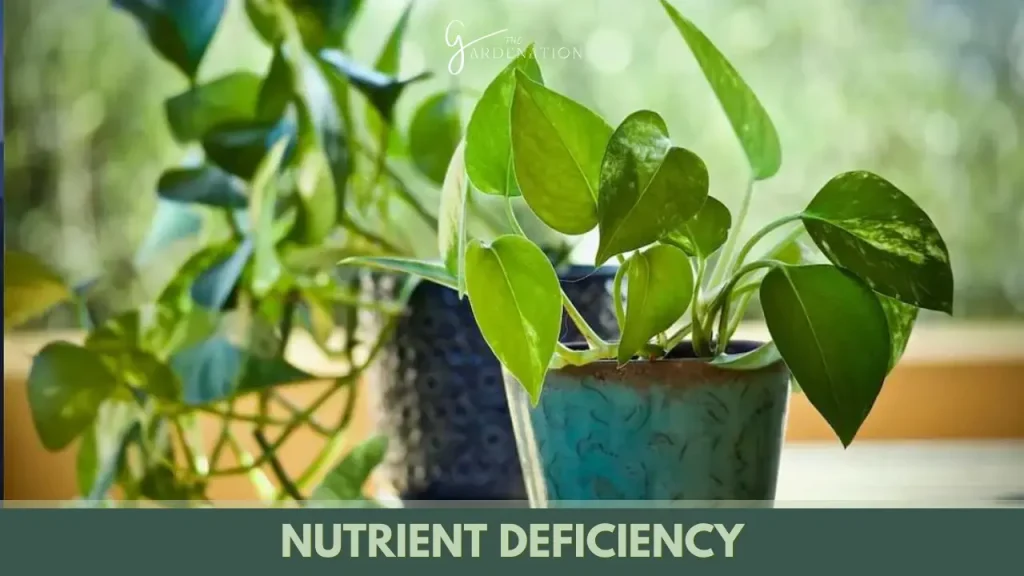
There are various nutrients in plants, each nutrient has its role in growth. Similarly each nutrient has its own deficiency and toxicity symptoms. So nutrient deficiency is a major concern in improper plant growth.
Nutrients that cause brown spots includes:
Potassium – Its deficiency plays a crucial role in water regulation and overall plant health. The deficiency causes brown spots on the margins of older leaves.
Magnesium- Lack of magnesium can also cause brown spots on pothos leaves . The spots start as interveinal chlorosis that progresses to brown necrotic tissues.
Treatment
- Application of mineral nutrients and fertilizers containing required minerals is the best and possible treatment of mineral deficiency. As it is essentiality criteria of the minerals that they can’t be replaced by any other constituents. You must also know what are the Causes Of Chinese Money Plant Leaves Curling
5. Poor Soil
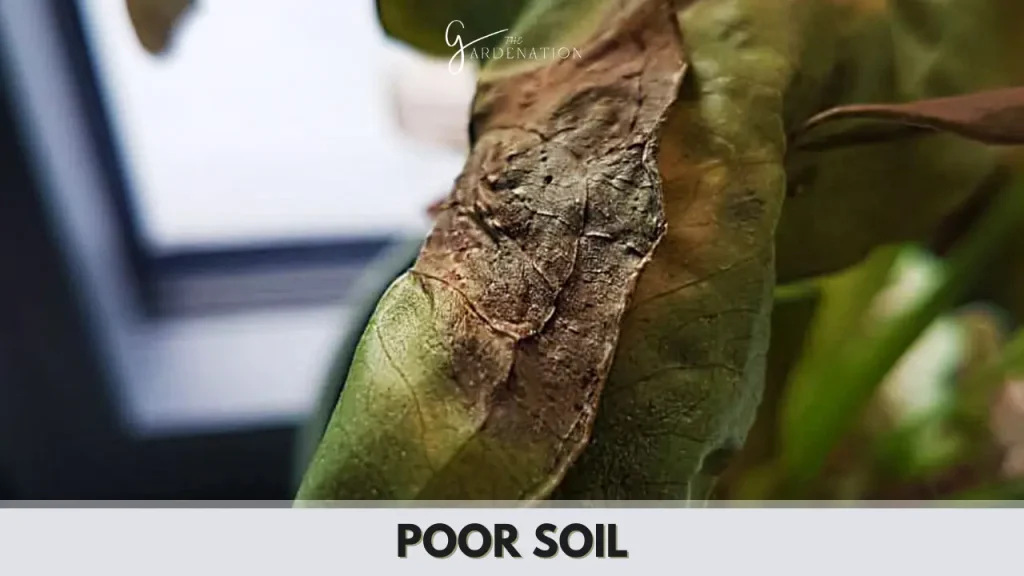
Poor soil conditions are equally harmful for plants as other factors. Such as acidic soil and saline soil. In case of low pH of soil the nutrients become unavailable even if they are given in case of fertilizers, plants will not be able to uptake them. So even in the case of nutrient rich soil. Soil low pH causes nutrient deficiency in leaves.
The lack of nutrients due to low pH results in similar effects as nutrient deficiency brown spots at leaves margins and browning following the interveinal cirrhosis leading to necrosis.
Another poor soil condition is salinity, it occurs when the soil EC is above desired EC level (4dS/m). It can be due to filling the pot with any soil without analyzing it or due to irregular use of fertilizers without any considerations.
The issue of salinity produces drought-like conditions for plants. But the concern is water is applied, still the plant refuses to take water. It is due to osmotic imbalancement. The concentration of salt is higher in soil than plant, which will create a hypertonic environment so instead of water entering the roots the roots will release their water.
As a result of salinity the edges of roots and tips of leaves will turn brown. The plant experiences slow growth and in severe cases leaf drop may occur. The leaves may develop a crisp texture due to lack of water.
Treatment
- Use of gypsum and other basic minerals to rise pH of soil to desired level.
- Use distilled water if possible to maintain salinity in saline soils.
- Leach down the excessive salt, by flushing the soil with excess water.
- Use fertilizer with proper guidance and consideration
- As we are using soil for pots, it’s better to replace soil with fertile soil with adequate pH and EC level.
6. Pest Attack
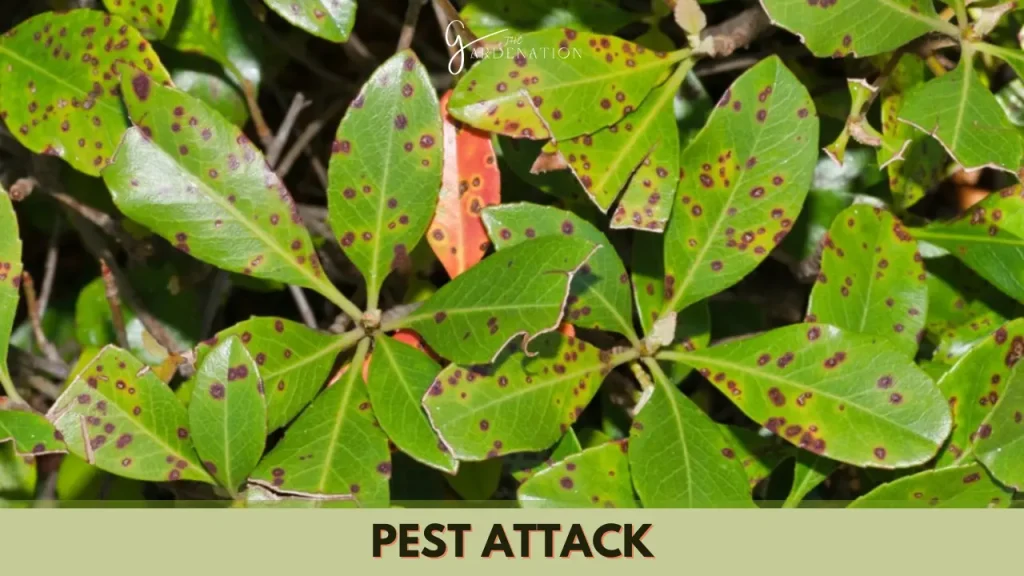
Pest infestation is another cause of browning of leaves of pothos. There are different pests such as scales, mites and thrips that are the major cause of browning in pothos leaves and other indoor plants.
Scales- They are small stationary insects. It sucks sap from leaves and stems. These insects appear as brown or greenish bumps and leave behind sticky residue. Severe infestation of scales lead to leaf yellowing, brown spots and eventually leaf drop.
Mites- Spider mites and other mites are small sap sucking insects. They suck sap from leaves and leave behind spots of discoloration including brown spots. They can be identified by webs on leaves.
Thrips- Thrips is another sap sucking insects affecting both leaves and fruits. They create silvery-brown scarring on leaves and also contribute to brown spots.
Treatment
- Use of neem oil as natural insecticide helps to reduce these pests.
- They can be identified and removed from leaves manually.
- Chemical control can be taken if necessary but it is not eco-friendly and can produce foul smell in the house .
- In case of severe pest infestation remove the most affected parts to prevent other parts from being infected.
7. Fungal Attack
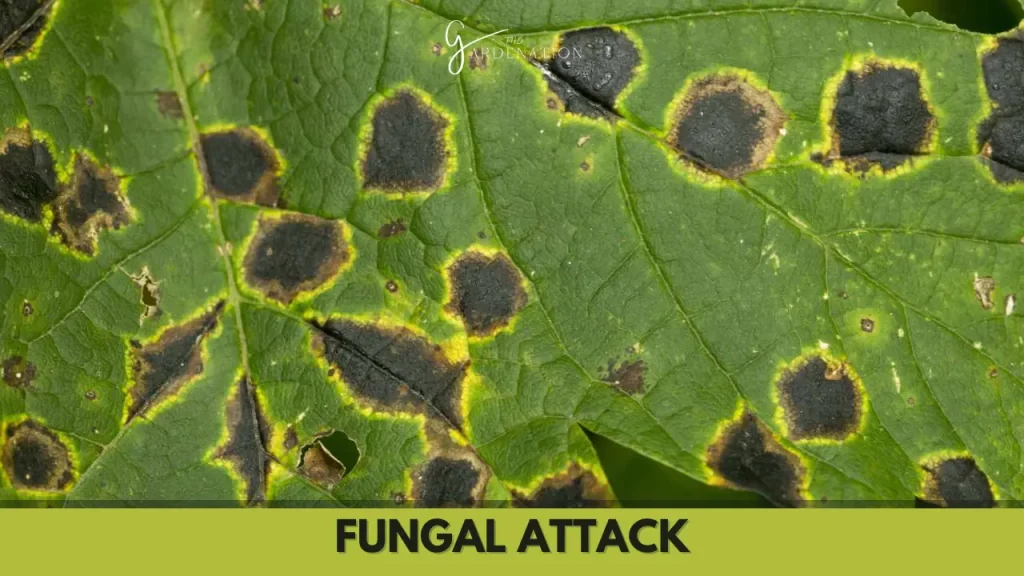
Several fungal diseases can cause brown spots on pothos leaves. The most common of them are;
- Rhizoctonia Root Rot- This fungus attacks the root zone, leading to stunted growth and yellow leaves with brown spots on leaves with soaked appearance. It occurs due to soggy and over watered conditions.
- Sclerotium rolfsii- This fungus causes Southern Blight in pothos, identified by tan or brown spots on leaves with yellow halos.
- Cercospora Myrothecium- It causes Leaf Spot Diseases in pothos with the appearance of brown spots. It spreads with moisture on the leaves.
Treatment
- Separate the infected pots to prevent disease spread in other pots.
- Cut off any infected part to prevent other parts of plants.
- Increasing airflow also aids in fungal prevention. As fungi find moisture and when we dry the soil, the fungi might die.
- In case of root rot, it is recommended to replace the pot.
- Apply broad spectrum copper based fungicide to chemically treat fungal infections.
These are the several reasons for the browning and brown spot appearance on leaves of pothos plants. Here I have also mentioned the possible symptoms and treatment. So after diagnosing the cause with proper care we can revive the health of our pothos plants.
Frequently Asked Question
Why should I use indoor pothos plants?
Using indoor plants can be an excellent choice for indoor decoration providing an elegant and natural look to the indoor spaces. These plants are good air purifiers and natural humidifiers in their own selves. Using Pothos for indoor planting is an excellent choice as they are small vines that can be grown easily in containers, making them suitable for table decorations and small spaces.
How to take best care of pothos?
Pothos are resilient varieties that are low maintenance and once established they don’t need much care. However, palace them under bright places not in direct sunlight and establish proper humidity. Plant them in well drained fertile soil and maintain frequent watering. Once it’s all given it grows best in its place.
Conclusion
Using indoor plants such as pothos for internal decoration is greatly encouraged, but due to unfavorable conditions brown spots formation on their leaves deteriorate the overall appearance of these plants.
There are several causes of brown spots on leaves such as sunburn, infrequent watering, fungal and pests attack, poor soil health and nutrient deficiency. If these concerns are treated timely we can maintain the health of plants and can even revive the almost dead plants.

